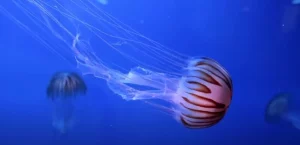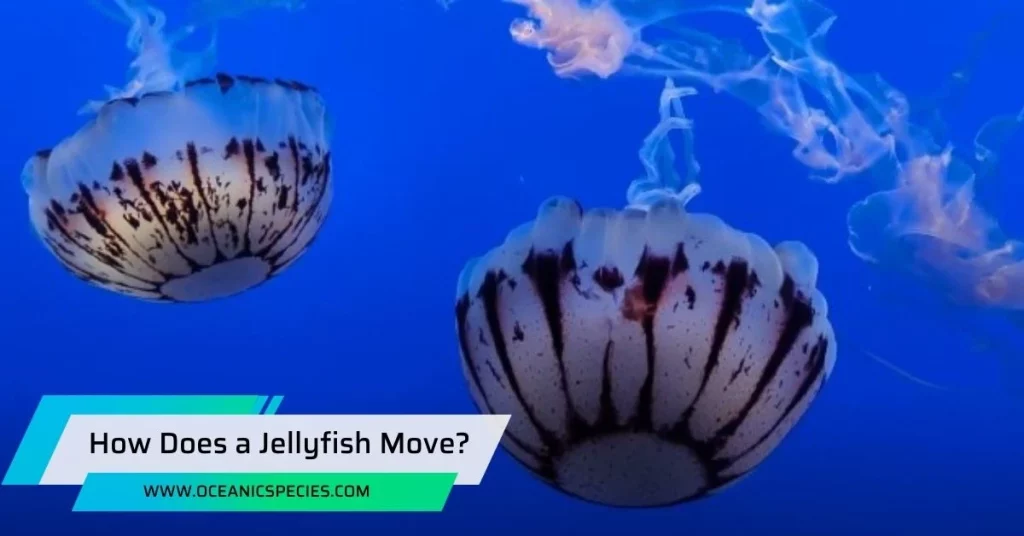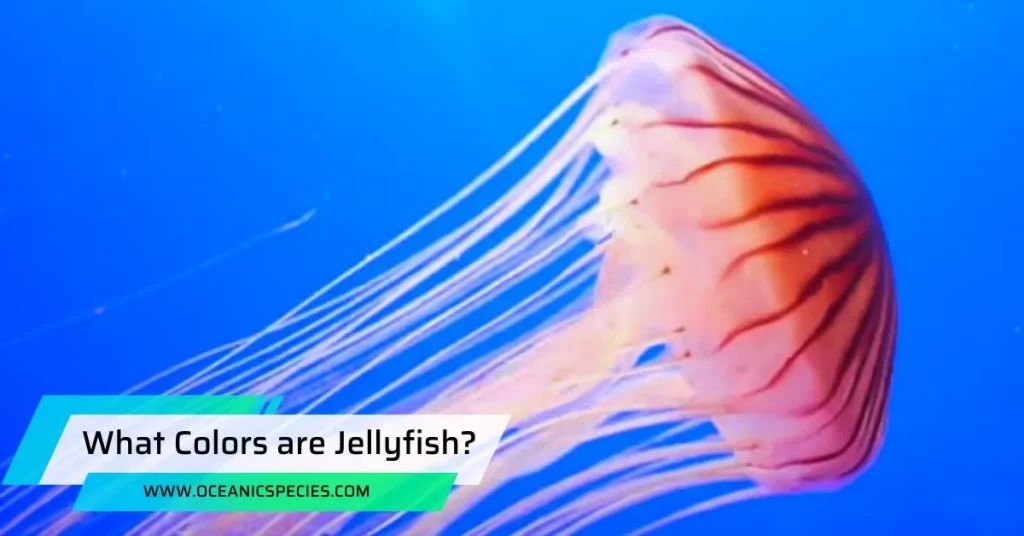Jellyfish move by using their umbrella-shaped bells to push off water, propelling themselves quickly and efficiently. Jellyfish, contrary to popular belief, do more than just float aimlessly in the ocean.
They actually have the ability to move through the entire water column. Despite their lack of fins and gelatinous bodies, jellyfish are incredibly energy-efficient swimmers. They achieve this by utilizing their bell, or the umbrella-shaped part of their body, to create a wall of water.
We will delve deeper into the fascinating world of jellyfish movement and uncover their secrets to efficient swimming.
The Amazing Adaptation Of A Gelatinous Swimmer
Jellyfish, despite their gelatinous bodies, are remarkably efficient swimmers. They use their umbrella-shaped bells to create a water wall, propelling themselves forward by pushing off from it.
Jellyfish’s Unique Biological Structure For Swimming:
Jellyfish have an umbrella-shaped body called a bell, which they use to propel themselves through the water. The bell is made up of a gelatinous substance known as mesoglea, which is flexible and allows for movement.
Inside the bell, jellyfish have a network of muscles that contract and relax, causing the bell to pulsate. These muscle contractions create hydrodynamic forces that propel the jellyfish forward.
The bell also acts like a suction cup, creating a low-pressure area that helps the jellyfish move through the water.
Evolutionary Advantages Of Their Gelatinous Bodies:
Jellyfish have evolved their gelatinous bodies as an adaptation for efficient swimming. Their gelatinous bodies are lightweight, allowing them to float and move through the water with minimal effort.
The gelatinous texture also reduces drag, allowing jellyfish to move smoothly through the water and conserve energy. The flexibility of their bodies enables jellyfish to change their shape and maneuver in different directions.
Their gelatinous bodies provide a protective layer against predators and other threats in the ocean.
The Power Of Jet Propulsion: Jellyfish’s Primary Mode Of Movement
Jellyfish, despite their gelatinous bodies and lack of fins, are remarkably efficient swimmers. They use their umbrella-shaped bell to create a wall of water and propel themselves forward, making them masters of jet propulsion for movement.

Explanation Of Jet Propulsion Technique:
Jellyfish move primarily through a unique mechanism called jet propulsion. This technique involves the ejection of water from their bells to generate forward movement. It is an efficient way for jellyfish to navigate through the water despite their lack of fins or muscles.
Mechanics Behind The Generation Of Forward Movement:
When a jellyfish contracts its bell, it forces water out in a powerful jet. This jet of water propels the jellyfish forward, allowing it to swim through the ocean. The movement is similar to a jet engine’s exhaust, creating a backward force that propels the jellyfish forward.
Comparative Analysis Of Propulsion Efficiency Among Different Species:
Different species of jellyfish display varying levels of propulsion efficiency. Some species have evolved to be more efficient in their jet propulsion technique. This efficiency can be attributed to factors such as the shape and size of their bells, as well as the strength of their contractions.
For example:
The moon jellyfish (Aurelia aurita) has bell-shaped bodies and uses gentle contractions to swim gracefully. Box jellyfish (Chironex fleckeri), on the other hand, have powerful contractions and streamlined bodies, enabling them to move quickly and efficiently.
Comb jellyfish (Ctenophora) use cilia instead of jet propulsion, but their propulsion efficiency is comparable to that of jellyfish.
The comparative analysis of jellyfish species’ propulsion efficiency provides insight into their adaptive capabilities and survival strategies in different oceanic environments.
The Role Of Cilia In Jellyfish Locomotion
Jellyfish move by using cilia, small hair-like structures on their bodies. These cilia allow jellyfish to create water currents that propel them forward in the ocean.

How Cilia Assist Jellyfish In Propulsion:
Cilia, which are tiny hair-like structures, play a crucial role in the locomotion of jellyfish. They are found on the surface of the jellyfish’s body, particularly around the oral arms and tentacles. Here’s how cilia assist jellyfish in propulsion:
- Cilia movement: The cilia beat rapidly in a coordinated manner, creating a wave-like motion that propels the jellyfish through the water.
- Generating forward thrust: As the cilia beat, they create vortices, or swirling currents of water, which generate forward thrust and push the jellyfish forward.
- Multifunctional role: In addition to aiding propulsion, cilia also help in capturing food particles and sensing the environment around the jellyfish.
An Exploration Of Cilia’S Movement Mechanism:
To understand how cilia assist jellyfish in propulsion, it’s important to explore the movement mechanism of these tiny hair-like structures. Here’s an exploration of cilia’s movement mechanism:
- Beating coordination: Cilia beat in a synchronized manner, thanks to the action of motor proteins. This coordination ensures efficient propulsion.
- Power stroke and recovery stroke: Cilia undergo a power stroke, where they bend in a specific direction, generating force that propels the jellyfish forward. This is followed by a recovery stroke, where the cilia return to their initial position.
- Fluid dynamics: The movement of cilia creates a complex fluid dynamics, as the interaction between the beating cilia and the surrounding water determines the direction and strength of the propulsive force.
The Significance Of Ciliary Swimming For Certain Jellyfish Species:
Ciliary swimming, enabled by the coordinated movement of cilia, holds great significance for certain jellyfish species. Here’s why ciliary swimming is important for these jellyfish:
- Energy-efficient locomotion: Ciliary swimming allows jellyfish to move through the water using minimal energy. This is particularly advantageous for species that need to migrate over long distances.
- Fine control over movement: The coordinated beating of cilia gives jellyfish precise control over their movement. They can adjust their speed and direction by altering the rhythm and amplitude of ciliary beating.
- Adapting to different environments: Ciliary swimming enables certain jellyfish species to thrive in environments with slow currents or areas where swimming against strong currents would require excessive energy expenditure.
The Secret Of Vortex Rings: Enhancing Jellyfish’s Swimming Speed
Jellyfish enhance their swimming speed through the secret of vortex rings. By utilizing their umbrella-shaped bells, they create a wall of water to push off and propel themselves more quickly, making them one of the most energy-efficient swimmers.
Creation And Utilization Of Vortex Rings By Jellyfish:
Jellyfish create vortex rings by rapidly contracting their bells, which pushes a pocket of water downwards. As the pocket of water moves downward, it forms a donut-shaped vortex ring.
The jellyfish then uses these vortex rings to swim by pushing against them, propelling themselves forward. By continuously creating and utilizing vortex rings, jellyfish can achieve efficient and effective movement through the water.
Unraveling Additional Techniques: Adaptations For Different Environments
Jellyfish propel themselves through the water by using their umbrella-shaped bells to create a wall of water that they push off from. Despite lacking fins and muscles, jellyfish are known for their energy-efficient swimming techniques.
How Jellyfish Navigate In Currents And Tides:
Jellyfish use a variety of techniques to navigate in currents and tides. They often rely on a combination of passive drifting and active propulsion to move through water.
Here are some ways jellyfish navigate in different currents and tides:
- Drifting: In calm water or weak currents, jellyfish may simply drift along with the water flow, using their gelatinous bodies to passively move along.
- Jet Propulsion: When faced with stronger currents, jellyfish can use jet propulsion to move forward. They contract their bell-shaped bodies, pushing out water in a forceful jet that propels them forward.
- Current Riding: Some jellyfish are adept at riding ocean currents, using them to their advantage. They will move up and down in the water column, riding the currents like a roller coaster.
The Influence Of Environmental Factors On Jellyfish Swimming Behavior:
Environmental factors have a significant impact on jellyfish swimming behavior. These factors can influence how jellyfish move and where they are found in the ocean. Here are some key influences:
- Temperature: Jellyfish are ectotherms, meaning their body temperature is determined by the surrounding water. Warmer water temperatures can increase their metabolism and swimming speed, while colder temperatures can slow them down.
- Salinity: Jellyfish are sensitive to changes in salinity levels. They tend to favor areas with stable salinity conditions, as drastic changes can disrupt their osmoregulation and swimming ability.
- Currents and Tides: Strong currents and tides can both aid and hinder jellyfish movement. They can use currents to their advantage for transportation, but excessively strong currents can make it difficult for them to swim against the flow.
- Food Availability: The presence of abundant food sources can influence jellyfish swimming behavior. They will actively seek areas with higher prey concentrations, adjusting their movement patterns accordingly.
- Predator Pressure: The presence of predators can greatly impact jellyfish movement. They may alter their swimming patterns or seek refuge in areas with lower predation risk.
The Role Of Sensory Systems In Jellyfish’s Directional Swimming
This ability to move and navigate in the water is fascinating, and it is largely guided by the jellyfish’s sensory systems.

Insights Into Jellyfish’s Sensory Capabilities:
- Statocysts: Jellyfish have specialized sensory organs called statocysts, which help them detect gravity and maintain their balance in the water. These tiny sacs are filled with small calcium carbonate crystals called statoliths, which move in response to the jellyfish’s movements. By sensing the position of these statoliths, jellyfish can orient themselves and adjust their swimming direction accordingly.
- Photoreceptors: Some jellyfish also have simple light-sensitive cells called photoreceptors, which allow them to detect changes in light levels. While they may not have the complex vision of higher animals, these photoreceptors enable jellyfish to detect shadows and variations in light, helping them navigate their environment.
- Chemoreceptors: Jellyfish possess chemoreceptors, which are sensory cells that allow them to detect chemicals in the water. These receptors help jellyfish locate food sources, detect predators, and navigate their surroundings. By detecting the presence of certain chemicals, jellyfish can make informed decisions about their movement and behavior.
How Sensory Inputs Guide Their Movement:
- Detection of water currents: Jellyfish can sense the direction and strength of water currents using their sensory systems. By detecting the flow of water around them, jellyfish can adjust their swimming pattern, either aligning themselves with the current for a more energy-efficient swim or swimming against it to reach a desired location.
- Response to light: Photoreceptors in jellyfish allow them to respond to changes in light intensity. When exposed to brighter light, jellyfish may swim deeper to avoid the surface, while dimmer light may cause them to swim closer to the surface. This ability to respond to light aids in their navigation and helps them find suitable habitats for feeding and reproduction.
- Food detection: Chemoreceptors in jellyfish play a crucial role in locating food sources. When jellyfish detect the presence of prey or the scent of a potential food source, they can alter their swimming direction to move towards it. This helps them efficiently forage for food and sustain their energy levels.
Relationship Between Sensory Systems And Swimming Efficiency:
- Adaptation to environment: The sensory systems of jellyfish are finely tuned to respond to environmental cues, allowing them to navigate their surroundings with remarkable efficiency. By constantly monitoring water currents, detecting changes in light intensity, and locating food sources, jellyfish can optimize their swimming patterns and conserve energy.
- Enhanced foraging abilities: The sensory capabilities of jellyfish enable them to efficiently locate and capture prey. Their chemoreceptors play a crucial role in detecting the presence of potential food sources, allowing them to adjust their movement and swim towards their next meal. This adaptability gives jellyfish a competitive advantage in the marine ecosystem.
- Survival strategies: Sensory systems guide jellyfish in making crucial decisions for their survival. By sensing water currents, light levels, and chemical signals, jellyfish can avoid predators, find suitable habitats, and maximize their chances of successfully reproducing.
The Future Implications: Innovations Inspired By Jellyfish Swimming Techniques
Jellyfish move by utilizing their bell-shaped bodies to create a wall of water for propulsion, making them highly efficient swimmers. Despite lacking fins, they are able to navigate through the water column with ease, dispelling the notion that they simply float aimlessly.
Potential Applications In Underwater Robotics And Biomimicry:
- Underwater robotics: Jellyfish locomotion techniques can be applied to develop more efficient and agile underwater robots. By studying how jellyfish move, engineers can create robots that can navigate through water with minimal energy consumption. This can be particularly useful in underwater exploration, oceanography, and marine research.
- Biomimicry: Jellyfish swimming techniques can inspire the design of bio-inspired propulsion systems. By imitating the motion of jellyfish, engineers can develop innovative propulsion systems that mimic the efficiency and maneuverability of these creatures. This can lead to advancements in various fields, including underwater transportation, military applications, and environmental monitoring.
Lessons Learned From Jellyfish Locomotion For Engineering Advancements:
- Efficient propulsion: Jellyfish exhibit remarkable efficiency in their movement through the water, using their bell-shaped bodies to create resistance and propel themselves forward. Engineers can learn from this and develop propulsion systems that minimize energy consumption and enhance maneuverability.
- Flexible structures: Jellyfish have soft and flexible bodies, allowing them to adapt to different water conditions and navigate in tight spaces. Engineers can apply this concept to design robots with flexible structures that can withstand harsh underwater environments and perform tasks that rigid robots cannot.
- Flow control: Jellyfish use vortices and jets of water to control their movement. By understanding how jellyfish manipulate fluid dynamics, engineers can develop innovative flow control systems that enhance maneuverability and efficiency in underwater vehicles and robots.
Frequently Asked Questions
Do Jellyfish Just Float Or Swim?
Jellyfish swim by using their umbrella-shaped bodies to create a wall of water and propel themselves.
Do Jellyfish Swim Or Drift?
Jellyfish swim rather than drift, utilizing their bell-shaped bodies to create water propulsion.
How Does A Jellyfish Move Without A Brain?
Jellyfish move by using their bell to create a wall of water and propel themselves.
Conclusion
Jellyfish may appear to be passive creatures, floating aimlessly in the ocean. However, their movement is anything but aimless. Despite lacking fins and muscles, jellyfish are incredibly efficient swimmers. They achieve this by utilizing their bell-shaped bodies to create a wall of water for propulsion.
By pushing off a pocket of water under their bell, jellyfish can propel themselves more quickly through the water column. The ability of jellyfish to move and swim throughout the water column showcases their adaptability and survival skills. They are not confined to a single depth and can navigate through various layers of the ocean.
The graceful movement of jellyfish is a testament to the wonders of nature and the marvels of adaptation. Their ability to swim efficiently without conventional means is a reminder of the complexity and ingenuity found in even the simplest of organisms.


